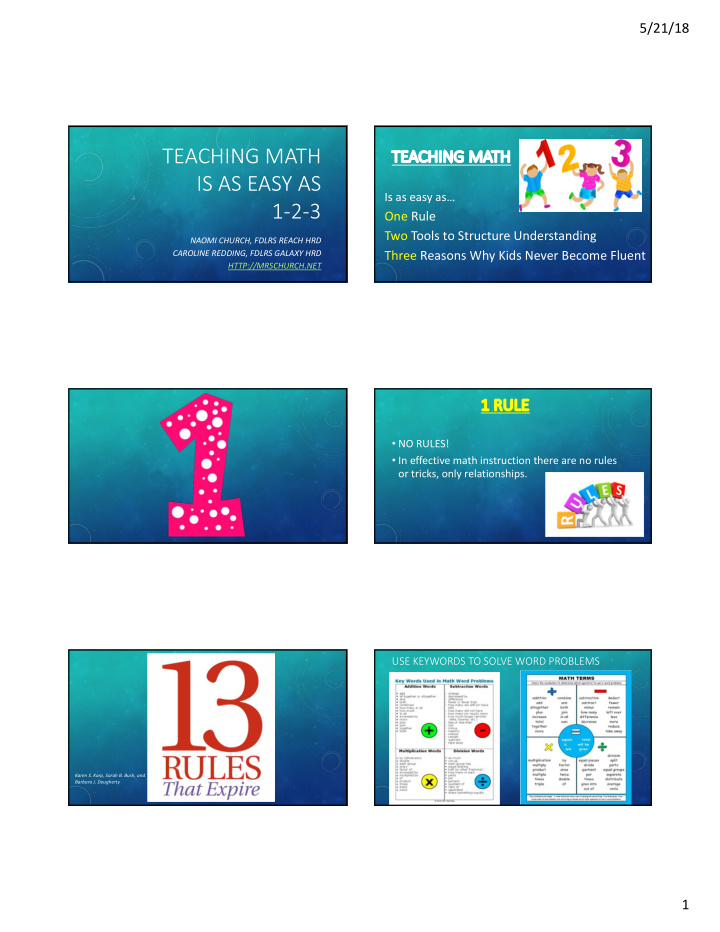



5/21/18 TEACHING MATH TE TEACH CHING NG MATH TH IS AS EASY AS Is as easy as… 1-2-3 One Rule Two Tools to Structure Understanding NAOMI CHURCH, FDLRS REACH HRD Three Reasons Why Kids Never Become Fluent CAROLINE REDDING, FDLRS GALAXY HRD HTTP://MRSCHURCH.NET 1 RU 1 RULE • NO RULES! • In effective math instruction there are no rules or tricks, only relationships. USE KEYWORDS TO SOLVE WORD PROBLEMS Karen S. Karp, Sarah B. Bush, and Barbara J. Dougherty 1
5/21/18 WHAT IS THE FUNDAMENTAL MESSAGE THE KIDS GET? • Don’t read the problem • Don’t imagine the situation • Ignore the context • Abandon your prior knowledge • Just grab those numbers and compute Arthur Hyde John had 14 marbles in his left pocket. ADDI ADDITION ON AND AND MULTIPLI LICATION ON AL ALWAYS MAK AKE He had 37 marbles in his right pocket. NU NUMBE BERS BI BIGGER How many marbles did John have? • Is this true? • Prove it. 32+67= • Telling isn’t teaching Negative numbers • Told isn’t taught -3+(-14)=-17 • It’s about experiencing the It was bad the first day you taught it… math 15+0=15 Same with multiplication… Karen S. Karp, Sarah B. Bush, and Barbara J. Dougherty 15x0=0 2
5/21/18 PEM PEMDAS 48 ÷ 2(9+3) = ? Order of Operations Grouping symbols ( ) { } [ ] exponents 3 2 x x 2 1 10 5 multiplication/division go fr from left ft to right esther g. � 2014 subtraction/addition go fr from left ft to right 2 2 TOOLS LS TO STRUCTURE UND UNDERSTAND NDING NG 1. Ten frame 2. Rekenrek 3
5/21/18 HO HOW MANY MANY DOTS WERE THE HERE? WA WAS IT EASIER TO DETERMINE THE AMOU AMOUNT OF OF DOTS IN THE HE SECON OND IMAGE? IM ? WHY? TE TEN FRAM AME WHAT DO YOU DO WITH A TEN FRAME? • Fiv e-Frame Tell-About •Comparing numbers • Ten-Frame Flash •Story Problems • Build a Number •Guess What? • "I wish I h ad. . ." •Roll and Build 4
5/21/18 USING TEN FRAMES WITH RESPONSE CARDS USING TEN FRAMES WITH RESPONSE CARDS RE REKE KENRE REK DIFFERENTIATING WITH REKENREKS WHAT DO YOU DO WITH A REKENREK? • String relationships (1 more/1 less, 2 more/2 less) • Quick Images • Show me _____________ (a number) • Part-Part-Whole • Who can show me the number in the least number of pushes? • Modeling Story Problems • Guess My Way (Have students show, then you show) 5
5/21/18 BUILD YOUR OWN! • Guess My Way • Show the Sum 3 3 REASO SONS S WHY KIDS S NEVER 1. 1. OVER RELIA IANCE ON COUNTIN TING BECOME FL BE FLUENT “Tasks that encourage students to think in 1. Over reliance on counting collections provide rich opportunities for them to construct abstract mathematical 2. The manipulatives we use relationships and become powerful problem 3. Lack of number sense solvers.” - Wheatley/ Reynolds 2010 2. TH THE MAN ANIPUL ULATI TIVES WE US USE “In the United States, the manipulatives most commonly used with young children are single objects that can be counted - Unifix cubes, bottle caps, chips, or buttons, while these manipulatives have great benefits in the very early stages of counting and modeling problems, they do little to support the development of the important strategies needed for automaticity.” - Fosnot 6
5/21/18 3. LACK OF NUM UMBER SENSE WHAT IS S NUMBER SE SENSE SE? The characteristics of good number sense include: Number sense is never complete - It is a a)Fluency in estimating and judging magnitude lifelong process that is promoted through b)Ability to recognize unreasonable results many and varied experiences with using c)Flexibility when mentally computing and applying numbers. d)Ability to move among different representations and to use the most appropriate representation. -Van de Walle Kalchman, Moss and Case (2001) WHY NUM UMBER SENSE? In a recent study of 180 seventh-graders conducted by the University of Missouri, researchers found that, “those who lagged behind their peers in a test of core math skills needed to function as adults were the same kids who had the least number sense or fluency way back when they started first grade.” -Neergaard, 2013 7
5/21/18 TE TEACH CHING NG MATH TH Is as easy as… One Rule Two Tools to Structure Understanding Three Reasons Why Kids Never Become Fluent A CONCLUDING THOUGHT We expect that the very best doctors will treat the most grievously ill patients. It should be no different in mathematics education. Great teachers have the skills to help the students who struggle the most. -Larson, 2011 President of NCTM Thank You! Naomi Church Naomi.church@browardschools.com Caroline Redding 50 caroline.redding@stlucieschools.org 8
Recommend
More recommend